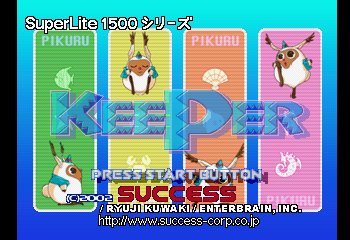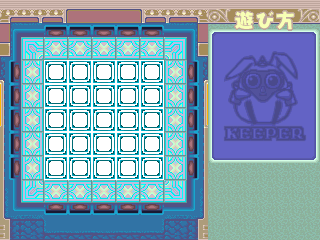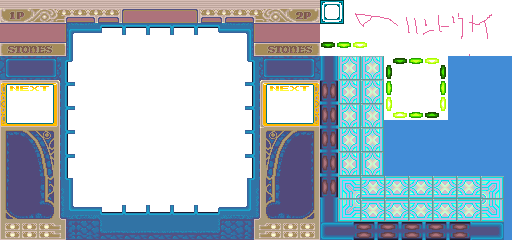Keeper (PlayStation)
| Keeper |
|---|
|
Also known as: Block Keeper (KR)
|
Keeper is a port of one of Success' successes from the early 1990s, originally on the Sharp X68000. Why they decided to port it to the PlayStation nine years later - and two after the PlayStation 2 was out - is left as an exercise to the reader.
Contents
Early Menus
A rather crude series of early screens can be found in the game's files, presumably from an internal operation demo build.
The Japanese text roughly translates to "operation demo".
Arcade Remnants
Ever wonder why this budget PS1 game's UX is so arcade-like, with timed menus, a drawn-out attract mode, and a difficulty system that exchanges starting at a later level for bonus points? Turns out that this version of Keeper seems to have been originally developed for a PS1-based arcade board, but Success unsuccessfully sought a distributor and ended up deciding to cut their losses. There are rumours that said arcade board was supposed to be the Taito G-Net and that it even made it into a location test at a Taito arcade in Shibuya in 2002, together with Sanvein, Battle Qix and Bomb Boat - all of which being fellow SuperLite PS1 titles with suspiciously arcadey feel. There seems to be no hard evidence for the existence of this location test, but the existence of arcade version remnants in all these titles except maybe for Sanvein and the fact that Success was the most prolific third party involved with the G-Net do corroborate the claim.
Bootup Screens
A run-of-the-mill legal notice about using Japanese arcade games outside Japan.
A screen with the logo of the port's developer, Fupac, who had also made the Super Famicom port. May have been used in the operation demo instead of the scrapped arcade version, if not on both.
Insert Coin(s)
These graphics are available in a variety of palettes. They are represented here in the ones used in the final version.
These lines are found in the bitmap with the start screen menu graphics.
Lines intended for the in-game and attract demo HUD. The "1P PUSH START" lines are used in the demo and their 2P counterparts are used during a one player game. The "PRESS START BUTTON TO START" goes unused, presumably intended to display after the player inserts a coin.
Continue Screen
Graphics for a continue screen. The retail version just boots you back to the title screen on game over. The border overlay is duplicated as a standalone bitmap file, which also seems to be unused.
Test Mode Remnants
| To do: Is there any code left for the test mode? |
Most arcade games have a test mode, accessible by pushing a hidden test button or by toggling a DIP switch. Keeper was not going to be an exception.
Graphics intended for the screen test.
References to Arcade Controls
| Unused | Used |
|---|---|
 |
 |
Arcade button and lever graphics for the tutorial. The PUSH! graphic is used in a different palette to the one pictured here.
| Unused | Used |
|---|---|

|

|

|

|

|

|
All references to "the button" were changed to the ○ button. Similarly, the lever is now referred to as the D-Pad.
Unused Tutorial Page
An unused page from the tutorial explaining the miracle orbs, a bonus item. It is unclear why this was scrapped.
Alternate Labels
The graphics for the labels and indicators for the special blocks and almighty multipliers are present both in katakana and in Latin letters, the latter of which goes entirely unused. The Korean version uses hangul. This bitmap is available in multiple palettes.
Keeper
Keeper.
Scribble
| ...But what does it mean? This game has text or audio that needs to be translated. If you are fluent with this language, please read our translation guidelines and then submit a translation! |
The bitmap for the in-game screen has a sloppily written note pointing to the empty floor tile graphic.
Unused Music
| To do: Is this really unused? The only place it could be used is when you win the game by reaching level 100, but I ain't good enough to check for myself |
The disc's two audio tracks have pointers to them on the disc's root as REMIX.WAV and TECH.WAV. They don't seem to be used anywhere. On the Korean version, these are actual WAV files contained within the data track.
REMIX.WAV:
TECH.WAV:
Regional Differences
In 2003, Success released four of their games in packs of two in South Korea through the local publisher Monosoft, one of which being Keeper. For some inscrutable reason, they decided to rename it Block Keeper for the Korean release. The other three games were released with their original titles. Notably, all the games were fully translated to Korean, a rarity at the time.
| Japan | Korea |
|---|---|
 |
 |
Besides the obvious title change, the references to Ryuji Kuwaki (designer of the original X68k version of Keeper) and Enterbrain (whose involvement with this port is unclear, however its fellow ASCII subsidiary Datam Polystar was the publisher of the original 1993 version) were removed for the Korean release. Likewise, a reference to the SuperLite 1500 Series, the budget game collection under which Keeper was released in Japan, was removed as well. The placement of some elements were slightly adjusted and the copyright year was updated from 2002 to 2003. Lastly, for some reason, the word "BUTTON" in "PRESS START BUTTON" was changed to lowercase.
| Japan | Korea |
|---|---|
 |
 |
The title of the game was also changed accordingly in the tutorial.
| To do: Any chance the intro music was accidentally disabled in the Japanese version by hardwiring a DIP switch setting to the wrong position? |
Oddly, while the Japanese version's intro is completely silent, the Korean version plays music. This song is only used on the intro.
- Pages missing developer references
- Games developed by Fupac
- Pages missing publisher references
- Games published by Success
- Games published by Monosoft
- PlayStation games
- Pages missing date references
- Games released in 2002
- Games released in October
- Games released on October 24
- Games with unused graphics
- Games with unused music
- Games with regional differences
- To do
- Articles needing translation/ja
Cleanup > Articles needing translation > Articles needing translation/ja
Cleanup > Pages missing date references
Cleanup > Pages missing developer references
Cleanup > Pages missing publisher references
Cleanup > To do
Games > Games by content > Games with regional differences
Games > Games by content > Games with unused graphics
Games > Games by content > Games with unused music
Games > Games by developer > Games developed by Fupac
Games > Games by platform > PlayStation games
Games > Games by publisher > Games published by Monosoft
Games > Games by publisher > Games published by Success
Games > Games by release date > Games released in 2002
Games > Games by release date > Games released in October
Games > Games by release date > Games released in October > Games released on October 24
















